
Count it all joy my brothers and sisters when you meet trials of various kinds – James 1:2
Paul asked me to keep an eye out for turkey tail fungus during my wanders through the woods. He’d just been diagnosed with Mesothelioma and he’d read how turkey tail (Trametes versicolor) helped the immune system to fight cancer. I didn’t hesitate to help this friend I’d recently reconnected with. It didn’t matter whether I thought the turkey tail would work. I think any benefits come from mycelium more than fruiting bodies. Still, the fruiting bodies make a comforting tea. Plus, Paul’s request was one more reason to wander around in the woods, and one more reason to visit him and enjoy his stories and laughter.
Paul was a friend who went all the way back to my young adulthood (or overgrown childhood) in the 70s. I’ve lived a few blocks from the Mississippi almost all of that time. Paul came from the town of Camanche just downstream. He was one of a group of friends who loved fishing, hunting, foraging, old timey music and partying – not necessarily in that order. Paul was a little wilder than most of us back then. I’ll never forget a vision of him out in front of a friend’s backwater cabin standing waist deep in water, grinning drunkenly and saluting. Under his feet was the boat that he forgot to put the drain plug back in before casting off. It was hard to imagine at that time that he would someday be the town’s mayor and even a pastor.
Paul changed a lot over the years, but a couple things never changed about him, his love of nature and his sense of humor. In the 70s I showed him, and other friends who liked to hunt morels, some different wild mushrooms that they could also hunt. These were the most basic edible fungi such as shaggy manes (Coprinus comatus) and Hen of the woods (Grifola frondosa) (or Hens the name I’ll continue to use for this mushroom). I also showed them sulfur mushrooms (Laetiporus sp.), oyster mushrooms (Pleurotus o. or p.) and a few more.
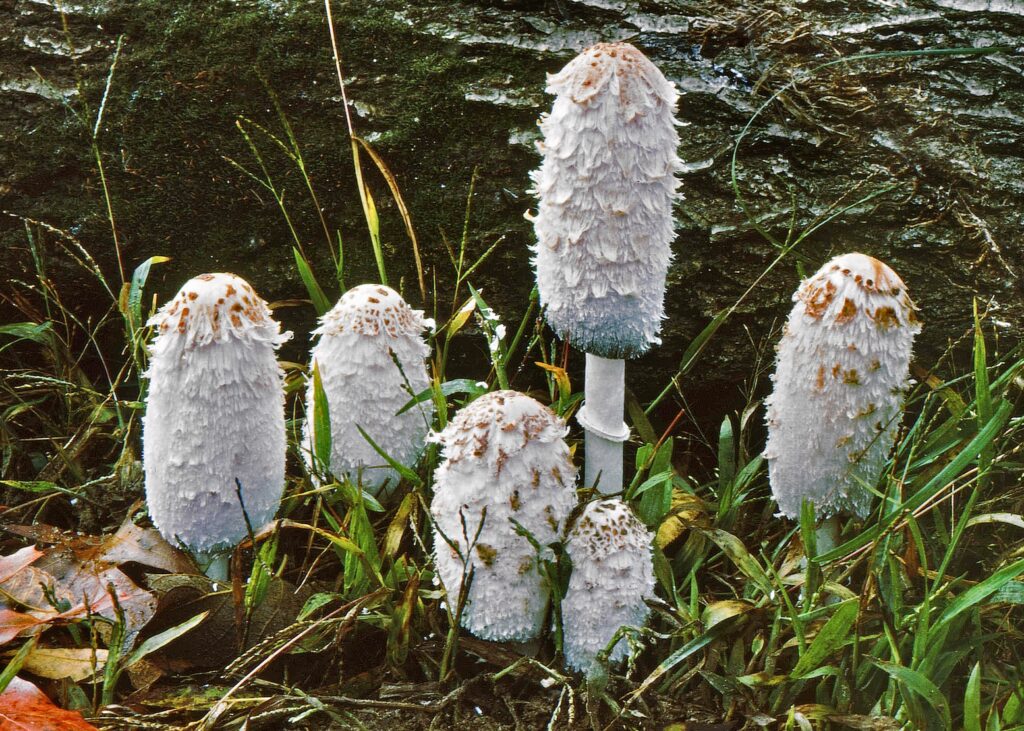
Shaggy Manes 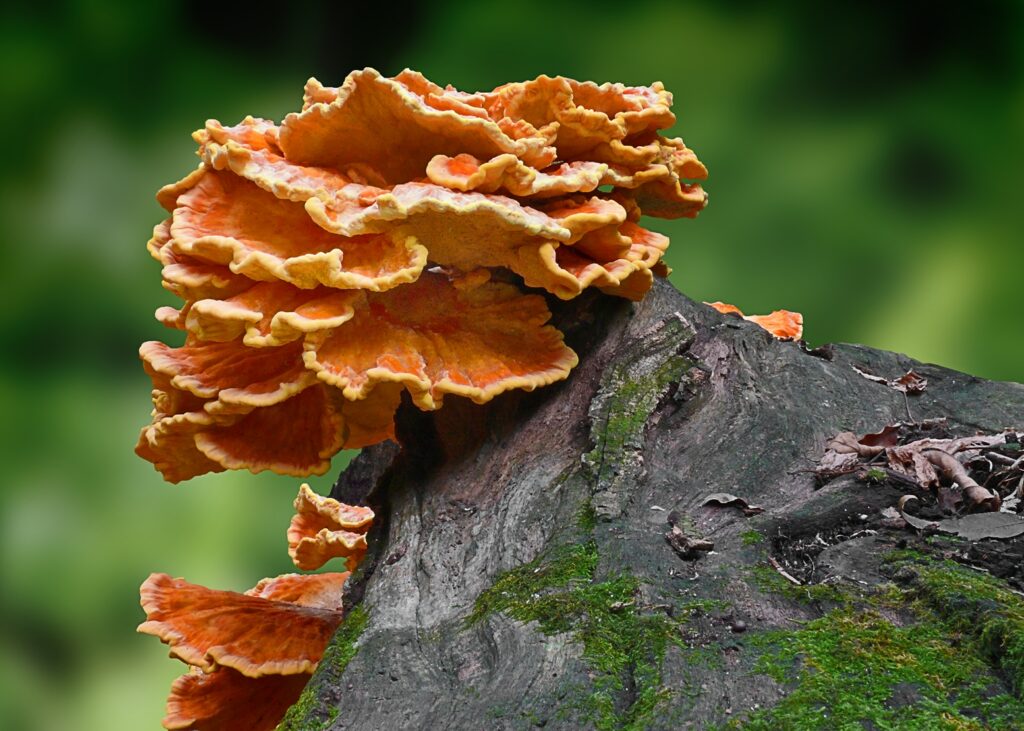
Sulfur Mushroom 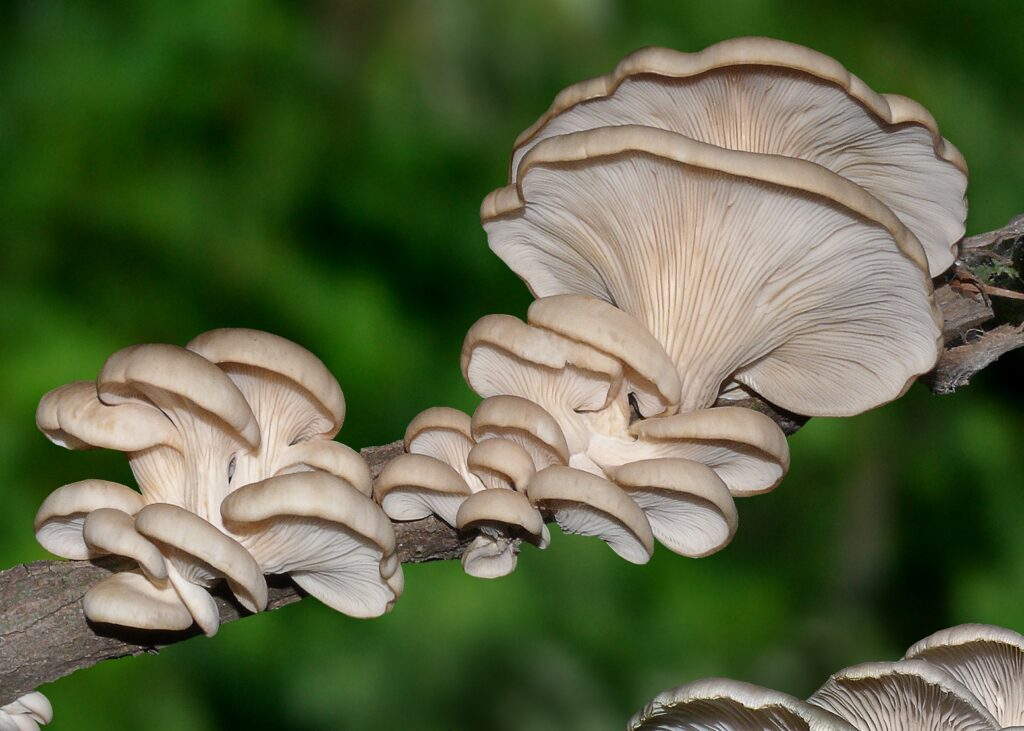
Oyster Mushrooms 
Hen of the Woods
I saw Paul only occasionally for the next three decades – until we reconnected at church in 2017. I guess I changed a little over the years too. You wouldn’t have expected to see me in church 40 years ago – more about that later. For now though, Paul and I were both now retired – yay! It turned out that Paul’s love of fungi continued all those years and he wanted to learn more. He especially wanted to learn how to safely identify honey mushrooms. I went on a fall walk with him and showed him the newly invasive Yellow oyster fungus (Pleurotus citrinoprunulis.) I also showed him the difference between honey mushroom Armillaria sp, wild enoki Flammulina velutipes, and deadly Galerina, all three of which are brown, grow on trees and were in the Fall woods at the same time. By the end of the walks he could tell the differences in the three species almost at a glance.
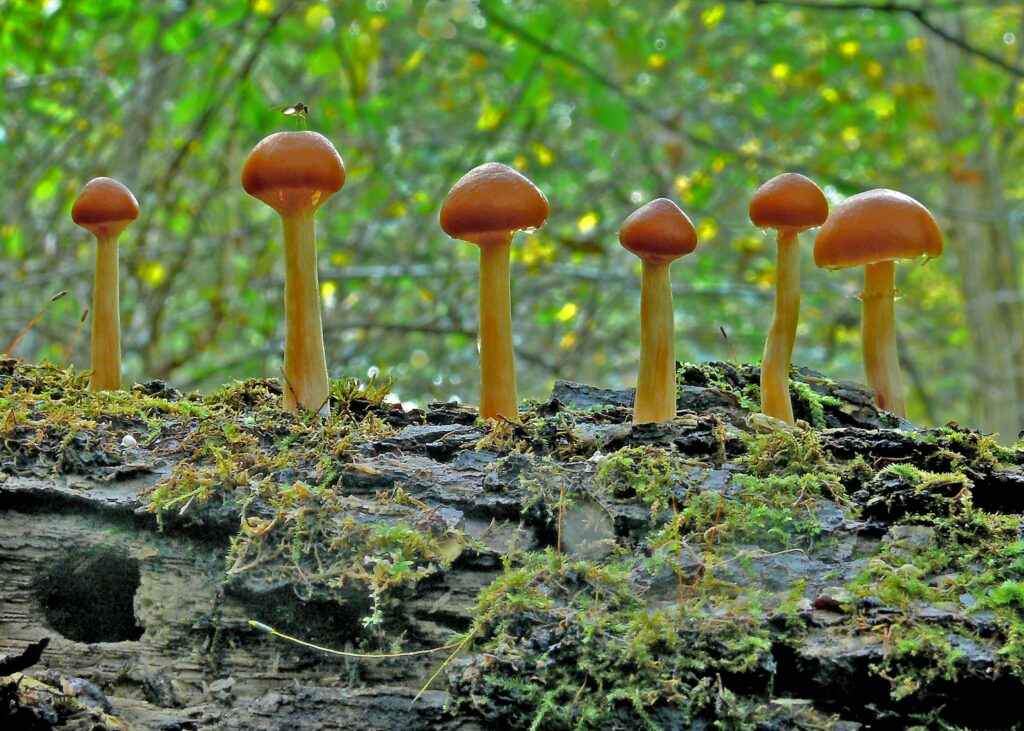
Deadly Galerina 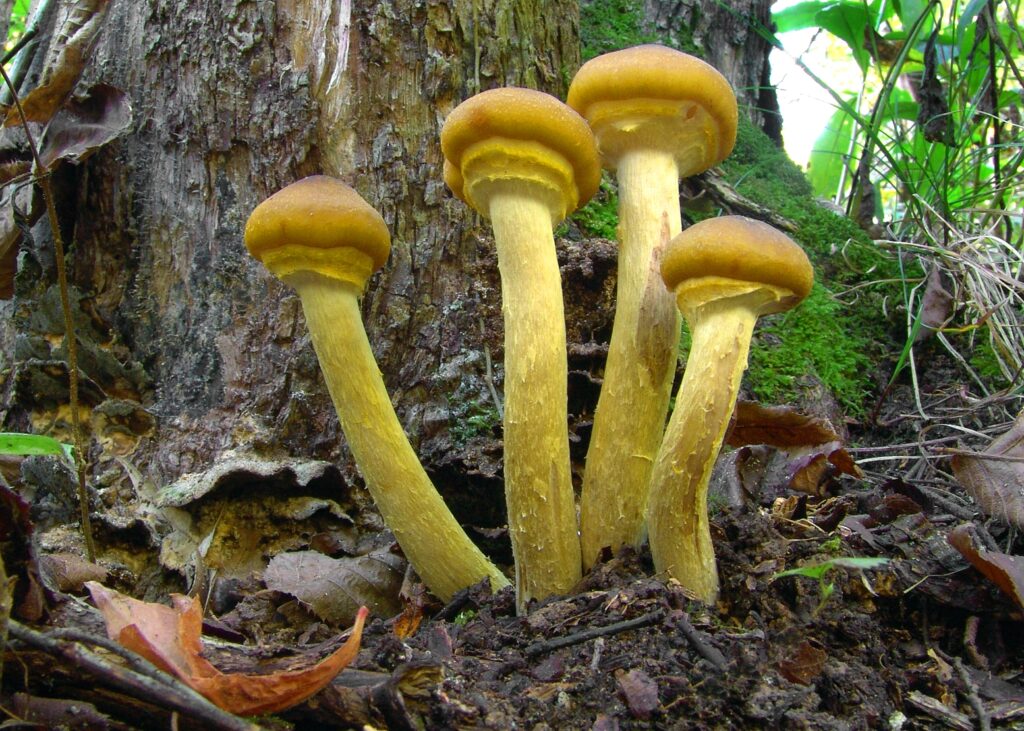
Honey mushroom 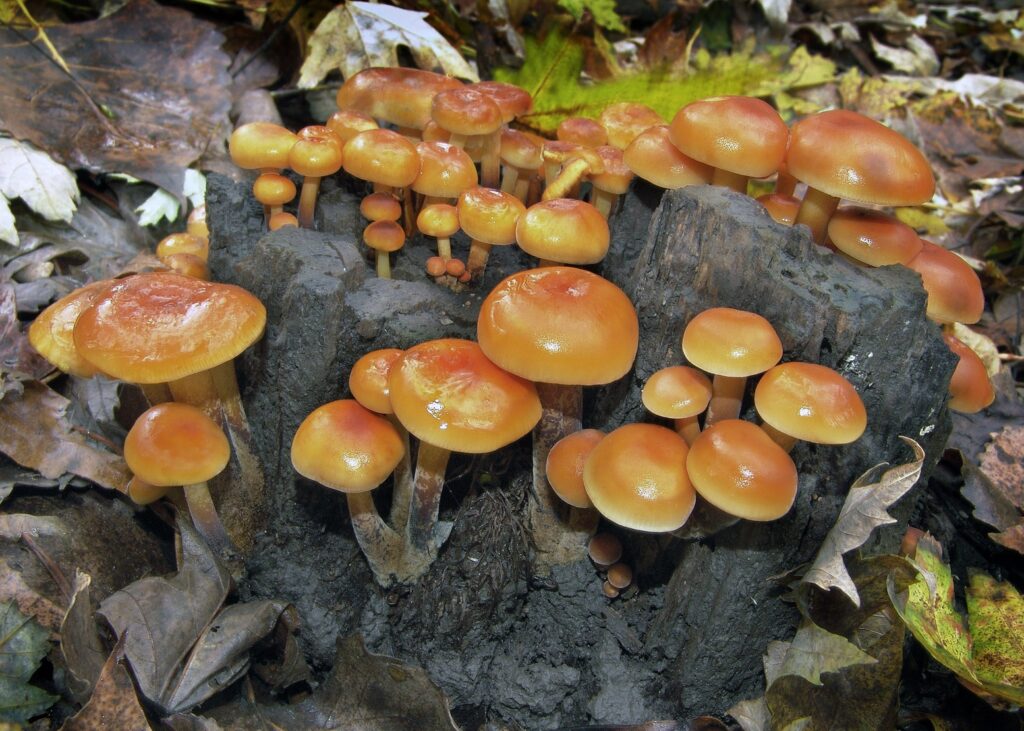
Flammulina velutipes (wild enoke)
Paul soon became too ill to walk the woods and find his own honey mushrooms and wild enoki. So I brought him some of those and/or hens along with the turkey tail which he made tea out of.
At first I was finding more false turkey tail then true turkey tail on logs. True turkey tail has almost velvety individually humped growth rings and visible irregular shaped white or off white pores. False turkey tails (Stereum sp.) are thinner, crisper and have a smooth yellow-tan underneath surface – no visible pores. Turkey tails usually have a broader coloration range too. However, there is so much color variation in true turkey tails that some may be shades of yellow and brown that look almost identical to Stereum on top of the cap.
Trichaptum sp. (purple tooth) can also look like a lighter colored turkey tail on top of the cap so much so that I had a handful in my bag before I noticed the spiked tooth-like pores with a purple hue underneath. Fortunately none of those made it to Paul. Though they would have been harmless, they would have shaken Paul’s faith in my mushroom guruness. I’m painfully aware of the limits of my mushroom “expertise.” However, I prefer that others, who know me too well, challenge my apparently authoritative pontificating as little as possible.
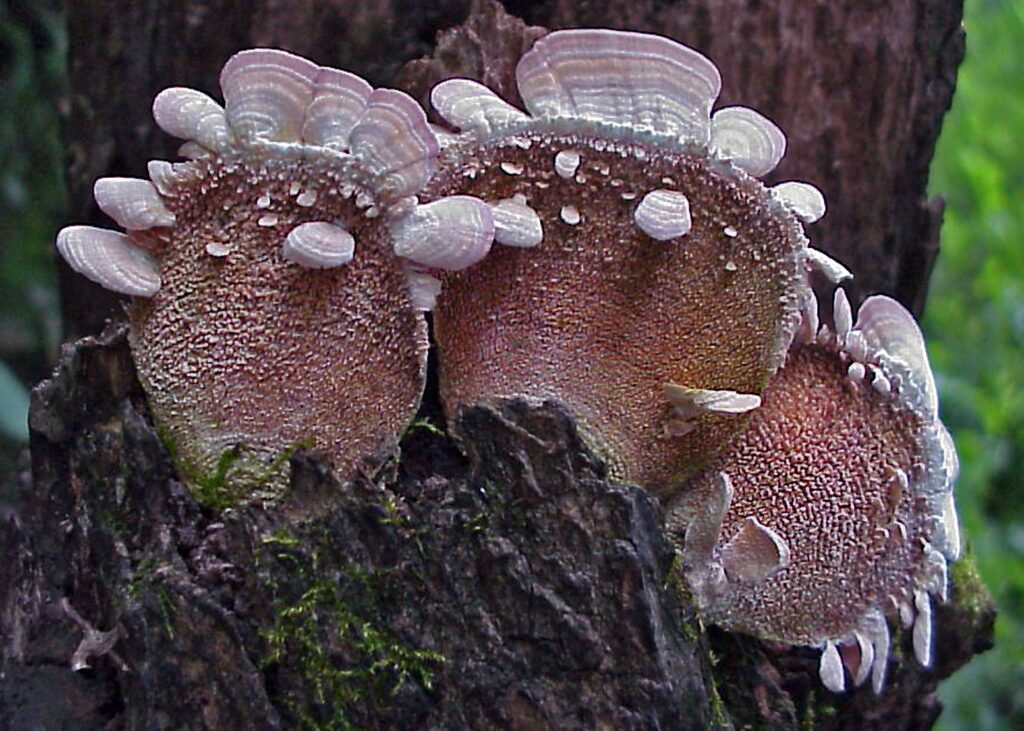
Purple tooth 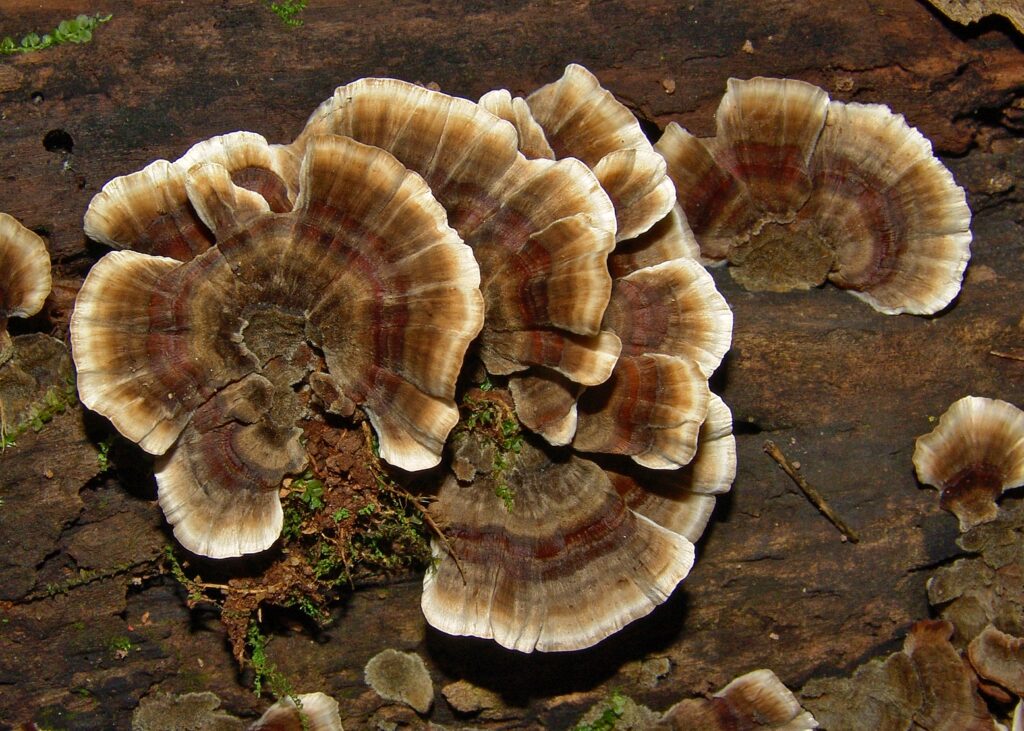
Turkey tail 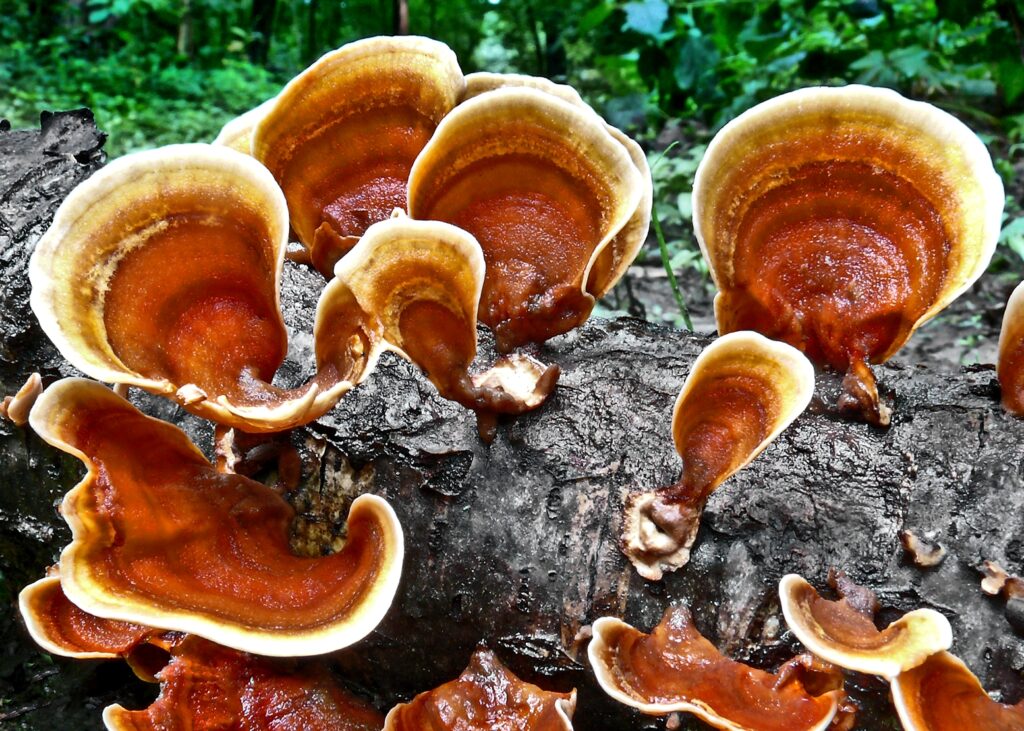
Stereum sp.
I was finding a little turkey tail here and there in my fall walks, but Paul was burning through it as fast as I was finding it. In January of 2018 Paul was out of turkey tails. He asked if they could still be good in the winter. I said they went dormant which accounted for the separate humped rings much like tree rings themselves. Still I wondered if some could be protected from the weather well enough to remain active.
I remembered a pile of huge logs in a ravine next to the cemetery. Some of the logs were five feet or more in diameter, creating mini cave-like environments on their undersides. That day I found turkey tails, but I also stepped on a rusty nail which nearly punctured my foot. Then a large log shifted perilously underfoot as I watched for dangerous holes deceptively covered over by grass and debris between the logs. I decided to avoid that woodpile despite its abundant fungi.
Now, on an icy January day, I knew that woodpile would be the one place I could go to find active turkey tail. So go I did. Now snow and leaves also covered the holes between logs. Soon my leg went into one – almost to my hip. As I slowly extricated my amazingly uninjured leg, I seriously weighed the health benefits of turkey tails with the health hazards of hunting turkey tails on this woodpile. Oh who was I kidding? I was having fun like I often am when I’m someplace I probably shouldn’t be.
I now tested every step until I got below the woodpile. There I found a completely different winter environment. Not only were active turkey tails abundant, there were a few fresh oyster mushrooms on the underside of a log. Some ubiquitous Schizophylum commune was just emerging. It looked younger, fresher and prettier here in the winter than it might in the summer. I’ll have much more to say about this common yet fascinating fungus in another post.
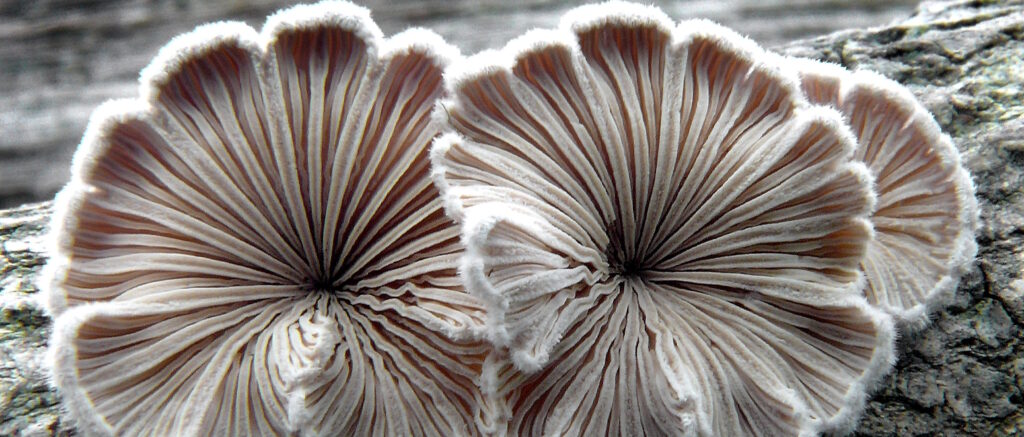
Schizophylum commune 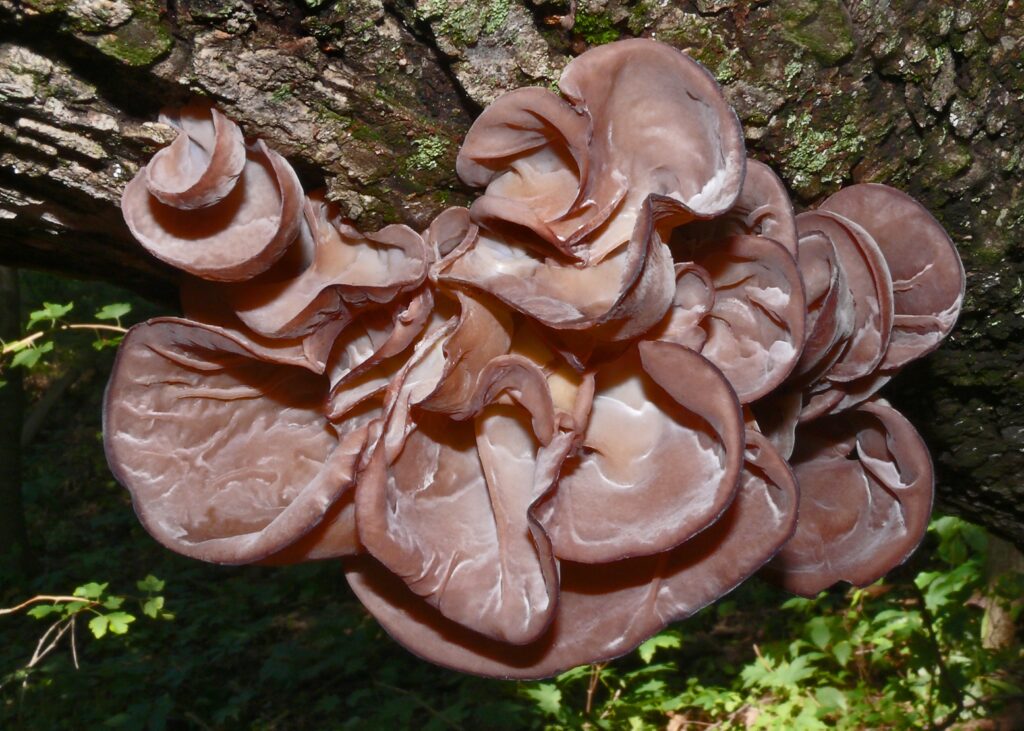
Auricularia auricula
The most amazing find this day was a standing dead elm covered with wood ear (Auricularia auricula) that had fruited in late fall then quickly dried without any precipitation before the hard freeze. Once frozen the snow didn’t affect them. They had a dark crisp look exactly like they would have if I’d picked them fresh, dried them in my dehydrator and stored them in my freezer for extra measure. Not only did I have a good bag of turkey tail for Paul, I now had an abundance of wood ear for Chinese stir-fry. I even had enough wood ear for Paul and his wife to try.
I returned to my car, staying well clear of that woodpile now. From a distance it all looked white and frozen, a solemn winter scene with the cemetery in the background. I never would have imagined that a woodpile could be so bountiful on a frozen winter day.
I wanted to believe that a higher power was helping me to succeed for Paul. In truth I couldn’t see turkey tails battling the monster raging inside of him at this point. The mushrooms I had for him were really just a way of saying I cared. I felt thankful on that winter day, for my health and for a surprising world filled with fungi.
Paul was no longer coming to church by the end of February and he was starting to use oxygen. It didn’t matter if no miracles were forthcoming from the turkey tail tea. He enjoyed its flavor and swore he felt better after drinking it. He enjoyed Turkey meatloaf with Grifola that Sally made and appreciated other frozen mushrooms that I brought him. Our conversation turned to the upcoming morel season still two months away. I commented on this being my first year in three decades when I could hunt for them any time, any day of the week. I told him to keep his appetite up because I’d bring him some of the first ones I found. He smiled and said, “That’s the plan.” In truth Paul knew that his plans mattered little anymore, for he said, “Really I just want to be a better witness.” Paul never ate any more morels. But he was a fine witness to the end.
Recipes:
Grifola Turkey Meatloaf
Wood Ear Stir-fry
*all photos except cross on mushrooms were taken by Jim Frink